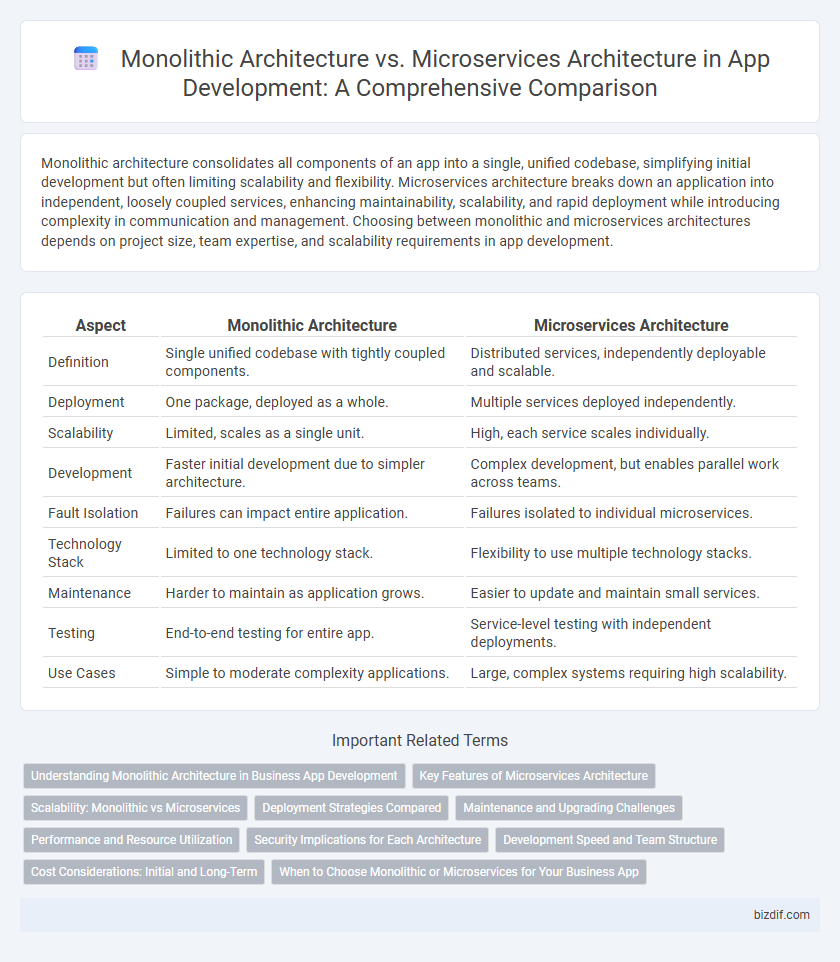Monolithic architecture consolidates all components of an app into a single, unified codebase, simplifying initial development but often limiting scalability and flexibility. Microservices architecture breaks down an application into independent, loosely coupled services, enhancing maintainability, scalability, and rapid deployment while introducing complexity in communication and management. Choosing between monolithic and microservices architectures depends on project size, team expertise, and scalability requirements in app development.
Table of Comparison
| Aspect | Monolithic Architecture | Microservices Architecture |
|---|---|---|
| Definition | Single unified codebase with tightly coupled components. | Distributed services, independently deployable and scalable. |
| Deployment | One package, deployed as a whole. | Multiple services deployed independently. |
| Scalability | Limited, scales as a single unit. | High, each service scales individually. |
| Development | Faster initial development due to simpler architecture. | Complex development, but enables parallel work across teams. |
| Fault Isolation | Failures can impact entire application. | Failures isolated to individual microservices. |
| Technology Stack | Limited to one technology stack. | Flexibility to use multiple technology stacks. |
| Maintenance | Harder to maintain as application grows. | Easier to update and maintain small services. |
| Testing | End-to-end testing for entire app. | Service-level testing with independent deployments. |
| Use Cases | Simple to moderate complexity applications. | Large, complex systems requiring high scalability. |
Understanding Monolithic Architecture in Business App Development
Monolithic architecture consolidates all components of a business app into a single, unified codebase, simplifying deployment and testing processes. This architecture often results in faster initial development cycles and easier debugging due to its centralized structure. However, scaling and updating individual features can be challenging, impacting flexibility and long-term maintainability in complex business applications.
Key Features of Microservices Architecture
Microservices architecture consists of independently deployable services, each responsible for a specific business capability, enabling scalability and flexibility in app development. It emphasizes decentralized data management, allowing services to manage their own databases, which enhances fault isolation and resilience. This architecture also promotes continuous delivery and integration, facilitating rapid updates and innovation across distributed teams.
Scalability: Monolithic vs Microservices
Monolithic architecture often faces scalability limitations due to its single unified codebase, making it challenging to scale individual components independently. Microservices architecture enables granular scalability by allowing each service to be scaled horizontally based on specific demand, improving resource utilization. This decoupled approach enhances overall system performance and facilitates dynamic load management in distributed environments.
Deployment Strategies Compared
Monolithic architecture typically requires deploying the entire application as a single unit, leading to longer release cycles and higher risk of downtime during updates. In contrast, microservices architecture enables independent deployment of discrete services, allowing for continuous delivery and faster iteration with minimal impact on the overall system. Containerization and orchestration tools such as Docker and Kubernetes are commonly used in microservices to streamline deployment and scale individual components efficiently.
Maintenance and Upgrading Challenges
Monolithic architecture presents maintenance challenges due to tightly coupled components, making updates complex and risk-prone, as a single change can impact the entire system. In contrast, microservices architecture simplifies upgrading by isolating services, allowing independent deployment and testing without affecting other modules. This modularity in microservices enhances scalability and reduces downtime during maintenance, ultimately improving overall system agility.
Performance and Resource Utilization
Monolithic architecture often delivers better performance due to fewer inter-service communication overheads and optimized in-memory processing within a single codebase. Microservices architecture enables finer resource utilization by distributing workloads across independent services, allowing dynamic scaling and efficient use of hardware resources. However, network latency and inter-service communication in microservices can impact performance if not properly managed with techniques like API gateways and service meshes.
Security Implications for Each Architecture
Monolithic architecture centralizes security controls, simplifying enforcement but increasing risk if a vulnerability is exploited, potentially compromising the entire application. Microservices architecture isolates services, limiting the attack surface and enabling tailored security policies per service, yet it demands robust inter-service authentication and increased monitoring to manage distributed risks. Effective security in microservices requires comprehensive identity management, encryption, and API gateway protections to mitigate threats across the complex, decoupled environment.
Development Speed and Team Structure
Monolithic architecture often enables faster initial development due to a unified codebase and simpler deployment process, making it suitable for small teams with tightly coordinated workflows. Microservices architecture supports parallel development across specialized teams by decomposing applications into independent services, which accelerates scaling and feature updates but introduces complexity in integration and deployment pipelines. Choosing between these architectures depends on the desired agility, team size, and long-term maintenance strategy in app development.
Cost Considerations: Initial and Long-Term
Monolithic architecture typically involves lower initial development costs due to its unified codebase, simplifying deployment and testing processes. However, microservices architecture, while often requiring higher upfront investment in infrastructure and expertise, can reduce long-term operational expenses through improved scalability, fault isolation, and easier incremental updates. Organizations must assess budget constraints and project scope to determine whether the predictable costs of monolithic systems or the scalable, flexible cost structure of microservices better aligns with their financial strategy.
When to Choose Monolithic or Microservices for Your Business App
Monolithic architecture suits businesses seeking rapid development and simple deployment with tightly coupled components, ideal for startups or small-scale apps. Microservices architecture benefits complex, scalable applications requiring independent deployment, fault isolation, and technology diversity, often favored by large enterprises. Choosing between them depends on factors like team size, application complexity, scalability needs, and release frequency.
Monolithic architecture vs Microservices architecture Infographic

 bizdif.com
bizdif.com